The Complete Guide to the Prevention, Treatment and Control of Midges in Singapore
Midges
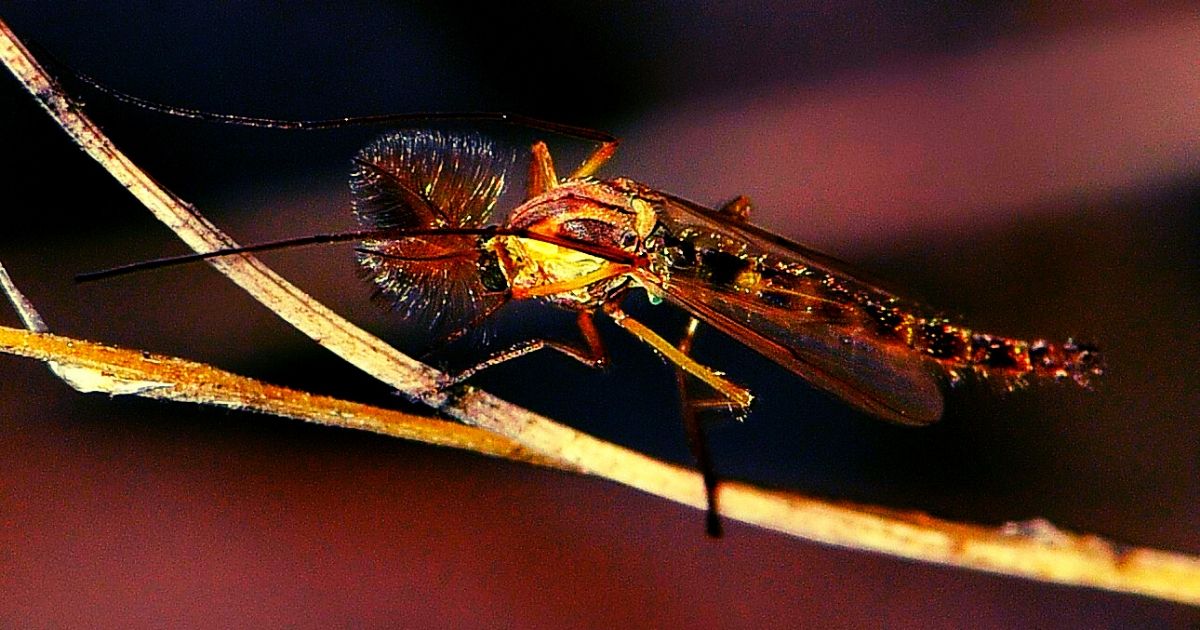
Midges are common insects in urban environments. In Singapore, it is not unusual to see swarms of midges near reservoirs. They can cause a lot of problems. These areas provide favorable conditions such as ample food in the water and optimal temperature during certain times of the year. A patron of an eatery in Teban Gardens recounted her experience with midges in Singapore:
“It was a fine afternoon and I was sitting at the corner of a bustling eatery, trying to fill my stomach after a morning of hard work. Set lunch was the perfect choice for a hungry soul. However, when I was about to start the lunch break with a sip of soup, I found that a bug was taking a nice warm dip in the soup. ‘Maybe I’ll skip the soup and let you have it.’ I told myself, and the bug. I was about to dig in when a swarm of bugs invaded my personal space and turned my peaceful lunch break into a horrifying experience that I will never forget.”
You may hear similar stories from people who live or work near Pandan Reservoir where tiny insects known as midges give the residents and local authorities serious headaches.
Table Of Contents
- Types of Midges
- Life Cycle and Biology
- Mosquitoes vs Midges in Singapore
- Signs of Midge Infestations
- Medical Importance of Biting Midges
- How to Prevent Midges In and Around your Home
- Tips to Prevent and Get Rid of Midges (DIY Methods)
- Professional Midge Treatment
- How do we Control Midges in Singapore
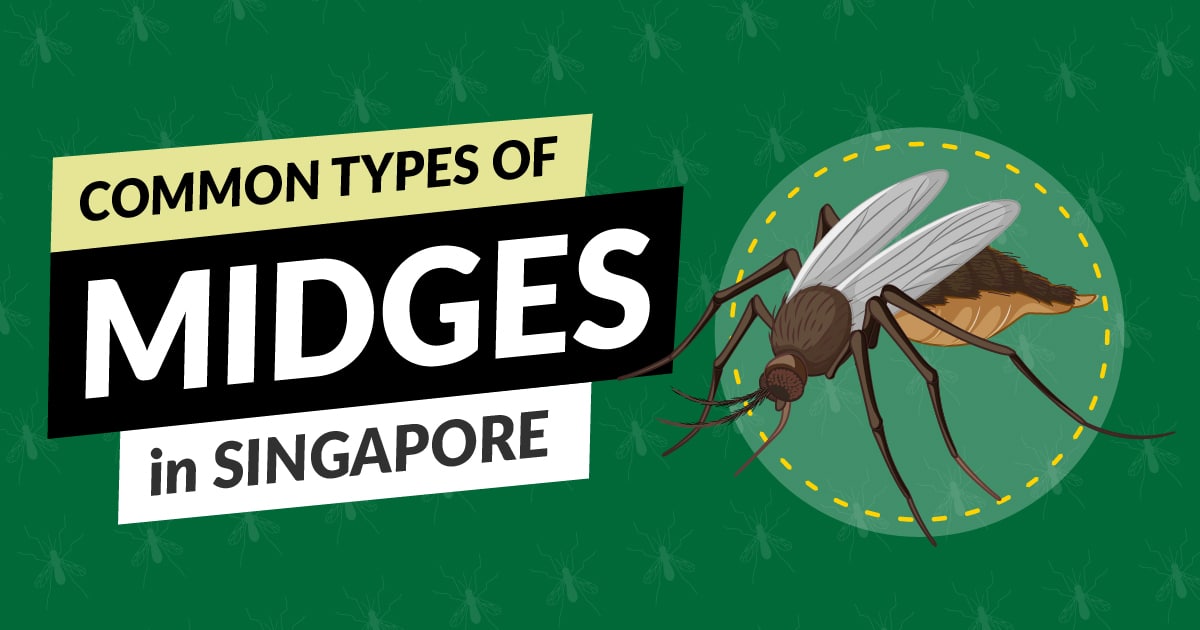
Types of Midges
Midges can be categorized into two main groups, namely:
Biting midges found in Singapore are in the family of Ceratopogonidae, while non-biting midges are in the family of Chironomidae. In Singapore, biting midges are also known as sand flies, but some may call them “No-See-Ums”. As the name implies, biting midges are bloodsuckers, leaving painful bites on human and animal skins. On the other hand, non-biting midges do not bite and feed like biting midges. Non-biting midges do not cause and transmit diseases to humans as mosquitoes do. However, they are defined as nuisance pests to humans.
Midges in Singapore can be found in stagnant or slow-flowing water bodies such as drains, ponds, lakes and water reservoir.
Life Cycle and Biology
The life cycle of midges is similar to that of mosquitoes. The life cycle of both biting and non-biting midges involves four development stages, namely:
- Egg
- Larval
- Pupal
- Adult
Biting midges
The complete life cycle of biting midges takes about 2 to 6 weeks, depending on the species and environmental factors. Both male and female biting midges feed on nectar. However, females require human or animal blood for their eggs to mature. Females usually fly into the male swarms for mating. This occurs when females finish feeding on blood.
Larvae development requires a moisture source. They need water, air and food for survival. Larvae develop in ponds, streams or muddy substrates, and they feed on organisms around them. The pupae stage can last from 2 to 3 days. The lifespan for an adult biting midge is usually up to a few weeks.
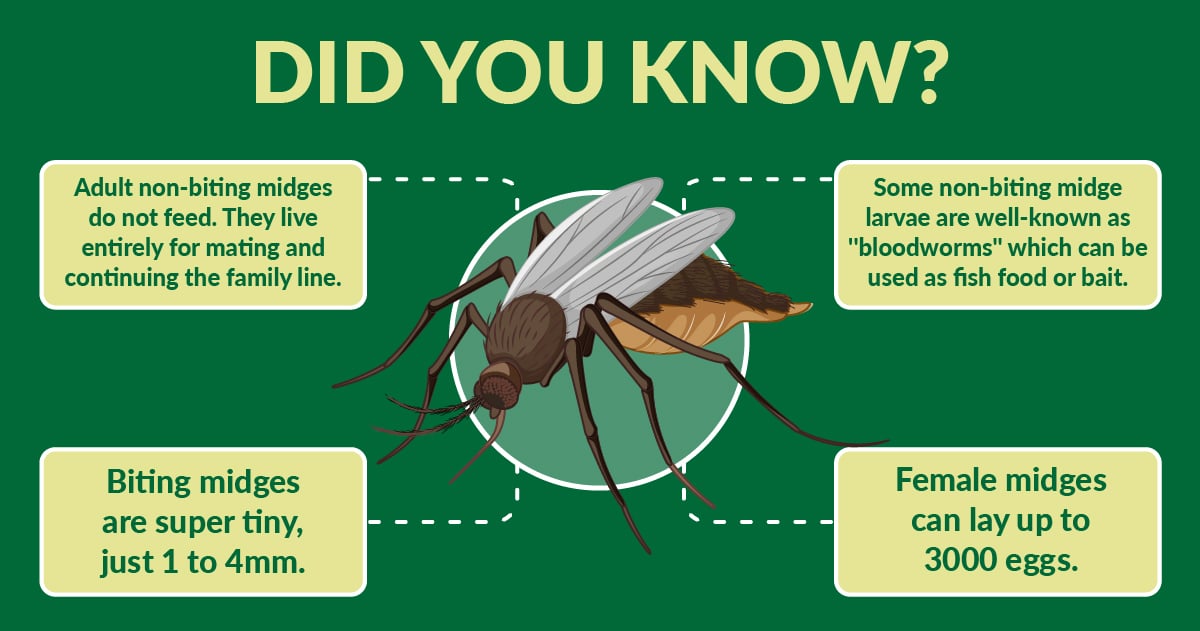
Non-Biting Midges
Non-Biting midges do not possess proboscis. The proboscis is a needle-like mouthpart found on insects such as mosquitoes and biting midges. It is an important feature used to suck blood.
The breeding habitats of non-biting midges are similar to mosquitoes, namely in stagnant water and slow-flowing water. Common places where you can find them are drains, water reservoirs, water tanks, ponds and lakes.
The complete life cycle takes about three weeks to complete. Non-biting midges have a better reproductive capability than biting midges. Female midges lay eggs on the water surfaces, in masses that contain up to 3000 eggs. After 2 to 3 days, the eggs sink to the bottom of the water where they hatch into larvae. They feed on sediments and organic matters that are found at the bottom of the water.
The larvae of certain species are well-known as “bloodworms” which are used as bait or fish food. After 2 weeks of larval development, the midges spend 3 more days in the pupal stage before they emerge as adults. Adult midges do not feed and they spend only 2 days of their lives entirely for mating and continuing the family line.
The high reproductive capability of midges causes a large number of eggs to be laid, and adults will emerge at the same time forming large swarms. Favorable conditions such as optimal temperature and the presence of ample food and breeding sites facilitate the emergence of a large number of midges in Singapore during certain times of the year.
Mosquitoes vs Midges in Singapore
Midges are often mistaken for mosquitoes for their similar appearance. However, their differences can be recognized upon close examination. Firstly, as adult midges do not eat or drink, they do not possess proboscis. The proboscis is a needle-like mouthpart found on insects such as mosquitoes and butterflies that are used to suck liquids such as nectar and blood.
Another distinct physical appearance of midges is that their bodies are usually longer and more slender than that of mosquitoes.
One of the most commonly found midges in Singapore has a distinct green colored body.
Unlike mosquitoes, midges do not transmit diseases and they are classified as nuisance pests.
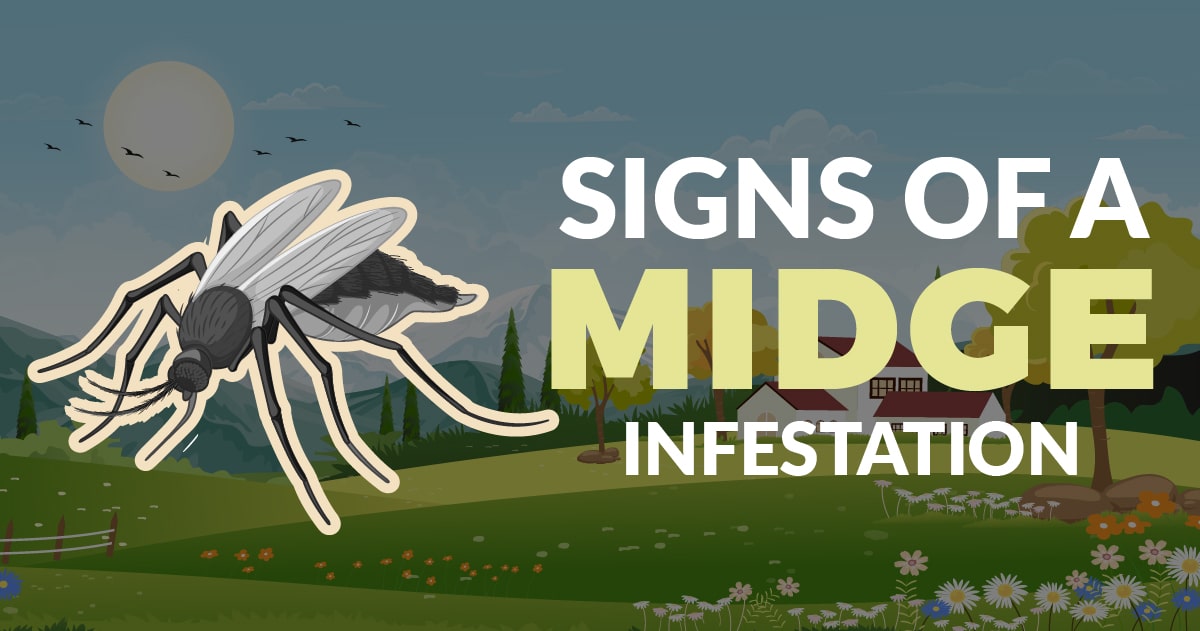
Signs of Midge Infestations
The swarming of midges is the most obvious sign of a midge infestation. You can notice the swarms, especially during dawn and dusk. Non-biting midges are harmless but are a nuisance to people. However, biting midges or sand flies can deliver painful bites, leaving red bumps that cause an itch.
Interesting fact: Some adult midges look similar to mosquitoes, but unlike mosquitoes, they do not eat or drink, and their bodies are usually longer and more slender.
Medical Importance of Biting Midges
Biting midges can cause a disease called leishmaniasis. Not to worry, there is no endemic transmission record of this disease in Singapore. Besides, the species that cause this disease are Phlebotomus and Lutzomyia spp., which do not appear active in Singapore.
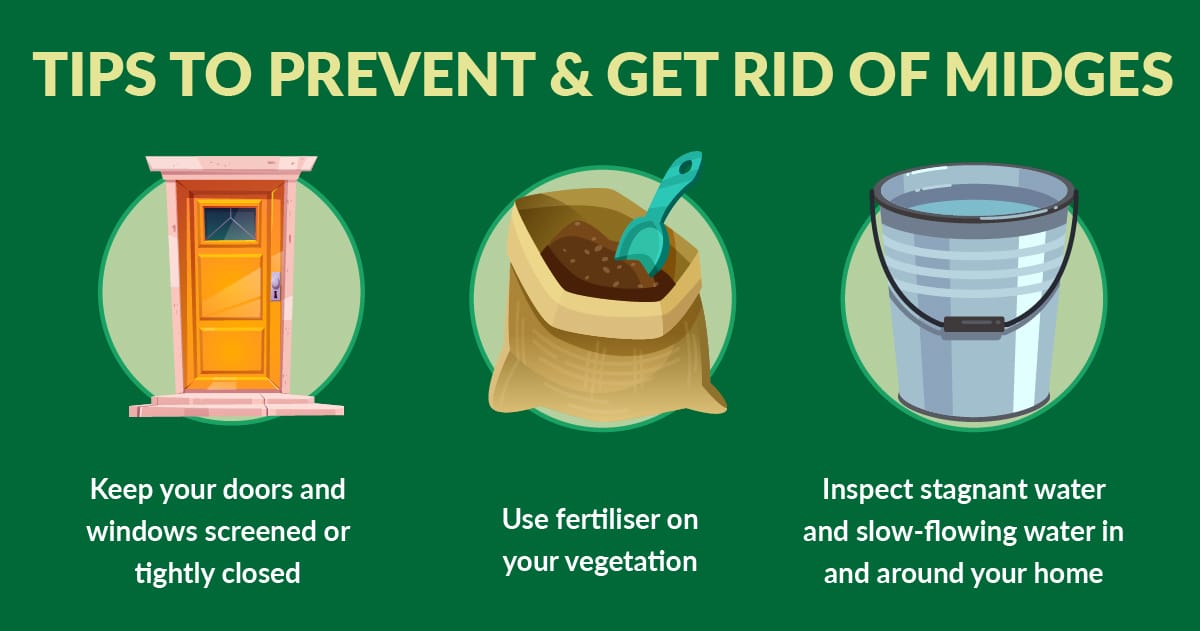
How to Prevent Midges In and Around your Home
1. Keep your doors and windows screened or tightly closed
To screen your windows, the wire mesh size must be small enough to exclude all species. Ensure always to remind yourself to close doors and windows, especially during dusk and dawn, as these are midges’ most active hours. Prevention during this time prevents Aedes mosquitoes as well. If you are not planning to screen your windows, you may install curtains to lower the chances of denying their access.
2. Always inspect stagnant water and slow-flowing water in and around your home
As previously mentioned, the developmental stages of the midges are similar to mosquitoes. They need to go through larval and pupal stages before emerging as adults. Midge larvae are most likely to be found in reservoirs, lakes and ponds. Other than that, they can be found in stagnant and slow-moving water.
The greenery and plants around the home are the most susceptible areas to become their breeding habitats. Stagnant water found on soil, in planter plates, or in boxes can become potential breeding places. Besides, the soil nutrients further contribute to the growth of their larvae, giving them access to ample food and enough water to survive through their developmental stages
3. Use fertiliser
Midge larvae prefer to develop in nutrient-rich habitats. Always remember to fertilise your plants properly by checking and following the guidelines of the fertiliser used. This is to prevent excessive use of fertiliser, resulting in fertiliser runoff in the soil to the surrounding ponds, drains, and streams. The excessive use of fertiliser can promote their growth of development as nutrients are drained from the soil to their breeding habitats.
Tips to Prevent and Get Rid of Midges (DIY Methods)
1. Use insect repellents
Insect repellents aim to repel midges away from you without killing them. Some people may have sensitive or allergy skin towards chemical-laden repellents. To protect sensitive skin from chemicals, you may apply natural insect repellents that contain substances such as citronella and tea tree oil from the market.
Although non-biting midges do not bite and transmit diseases, they can be a nuisance. Application of insect repellents is the easiest and most environmentally friendly method to protect you from midges‘ disturbance.
2. Use dim or yellow lights
Midges are highly attracted to bright light. Hence, yellow or dim light bulbs are advised, especially at doors and windows. In addition, you can always switch off the lights that are not in use in the exterior part of your home. This method is not aimed at eliminating midges but can help to reduce the presence around your living environment.
3. Make the environment less conducive (eliminate their habitats)
The reasons for midges to breed around your home are always the presence of stagnant and slow-moving water bodies. This includes over-watering of plants, hardened soil and insufficient drain gradient. Overwatering of plants and hardened soil in the planter boxes often cause the formation of stagnant water on the soil.
Always make sure to loosen the soil regularly and avoid over-watering plants to prevent the formation of ponding water. On the other hand, you may need to remove blockages such as stones, dry leaves, debris and algae formed in the drains regularly to improve the flow of drain water. You may also re-grade your drain if a poor gradient was found as midge larvae can withstand the weak water current in the drain.
4. Use Bti or mosquito dunk
Bti (Bacillus thuringiensis israelensis) or mosquito dunks can easily be bought in stores. These can be placed safely in and around your home if the formation of stagnant water bodies is difficult or troublesome to be cleared.
Bti is a bacterium that can infect the guts of mosquitoes and midge larvae. It is environmentally friendly as it does not affect or kill beneficial insects, aquatic animals and plants. Bti can be introduced into ponds, poorly maintained water fountains and gutters.
Want to find out more about midges removal in Singapore?

Professional Midge Treatment
It is quite a simple task to deal with a small number of midges present at your premises. However, it can become challenging to control midges when their numbers increase and start affecting your daily life.
Although non-biting midges are harmless and do not bite humans, a large number of them are a nuisance and can interfere with outdoor activities. It is almost impossible to eliminate them completely as they are part of nutrient-rich aquatic habitats. However, tackling them using drastic measures is sufficient to control them under the threshold level.
The treatment methods used in Singapore for midges can be divided into the following methods:
- Physical
- Biological
- Insecticidal
The most basic physical method is the removal of their breeding sources. Inspection plays a vital part in reducing the midge population. Remove midges‘ breeding source via S&D (search and destroy), i.e. remove midge eggs floating on the surface of the reservoir.
Some other methods have been used in Singapore. For example, a 3 metres high netting was introduced at the reservoirs to prevent the adult midges from flying or being blown to the residential areas (midges are weak fliers, easily blown by wind). Furthermore, to attract adult midges from keeping within the reservoirs, strong spotlights at pumping stations of reservoirs remain on from 7 am to 7 pm.
The application of Bti (Bacillus thuringiensis israelensis) is one of the biological methods that the government and pest control industries use.
Biological approach of using Bti (Bacillus thuringiensis israelensis) larvicide is one of the environmentally friendly practices used to kill midge larvae.
This is because it is safe (no risk to humans, animals and aquatic life), target specific and does not affect the water quality. Bti is a naturally occurring bacterium in soil that is capable of producing toxins that are only specified in targeting the larva of aquatic insects.
Hence, it is safe as it does not pose any risk and toxicity to humans and animals. More importantly, water quality is not affected by Bti application. PUB of Singapore is doing well in applying and increasing the dosage of Bti to the bottom of the reservoir to prevent the larvae from hatching into the adult stage.
Another biological method that the government uses is the release of predators to hunt for midge pupae (the prey), reducing the population of adult midges. In Singapore, thousands of predatory fish (guppies, mollies and swordtails) were released into the reservoirs as they are the predators of midge pupae. The strategy is to target the pupae of midge, which act as the prey of those released fish.
Pro Tip: To help control this pesky pest, you may want to consult professional pest management companies.
Furthermore, insecticidal approaches are commonly used in pest control industries in Singapore, namely:
- Thermal fogging
- Misting
- Larviciding
Thermal fogging and misting are two treatment methods to target adult flying insects, especially mosquitoes and midges. Thermal fogging targets flying insects present during the treatment period. Misting creates a residual effect on the treated surface and kills them upon contact. In short, thermal fogging acts as a “quick fix” solution to provide fast control to reduce the population of targeted insects while misting protects over a more extended period.
On the other hand, larviciding is the application of larvicide into stagnant water. It is used to target larvae before they can grow to adults.
The substantial number of non-biting midges present in Bedok and Pandan reservoirs of Singapore has led to the increase of fogging frequency to twice daily by PUB (Public Utilities Board). The reason for this is to target the most active time of non-biting midges in Singapore so that they will interfere with the treated zone during their swarming activities.
Fogging is carried out as a “quick fix” solution to those flying adult non-biting midges. The chemical used is permethrin, which is certified and recognized by both WHO (World Health Organization) and NEA (National Environment Agency). Reservoir dykes, drains, and surrounding vegetation at Bedok and Pandan are the focal point for treatment as those are the breeding sources of midges in Singapore.

Pest Problem? Let Us Help.
We offer fast and effective precision treatments to eliminate pests while ensuring a safe environment for your home or business.
How do we Control Midges in Singapore?
Licensed and certified companies in Singapore strictly carry out all the methods discussed here. At Killem Pest, we provide a physical approach by carrying out S&D (search and destroy). Inspection is not an easy challenge. Our pest control professionals are trained to have the required knowledge and ability to search for midges breeding places.
Besides, environmental health is always our concern. Hence, we also offer a biological approach by providing or applying Bti upon request or in sensitive areas. In addition, all the chemicals used in insecticidal methods are approved by NEA (National Environment Agency). The chemicals do not pose harmful effects to humans and animals.
Controlling the population of midges in Singapore is not an easy challenge but we are certainly taking it on. With more research and knowledge about the insects, we will be able to come up with new innovative measures to keep their populations under check.
Frequently Asked Questions
Midges don’t transmit any human diseases, however, it’s known that their bites can be painful and can cause a severe allergic reaction.
Midges can cause discomfort for people, but they are not considered dangerous. On the other hand, midges can spread diseases to animals, like livestock, and can be considered deadly.
The best way to protect yourself from biting is to cover up your skin. Choosing light-coloured clothing can also help, as midges are attracted to dark colors.
Yes, midges can appear in your house, and once they do, you may find it difficult to get rid of them.
Midges look similar to mosquitoes, they have the brown colouring of their bodies and wings, long wings, skinny legs, and bodies that extend the length of their wings.
Midges usually live near water and moist places, like ponds, rivers, damp soil, and others. Since there are so many of them, they can clog up the air filtration systems.
7 Tips on How to Get Rid of Midges
Midges
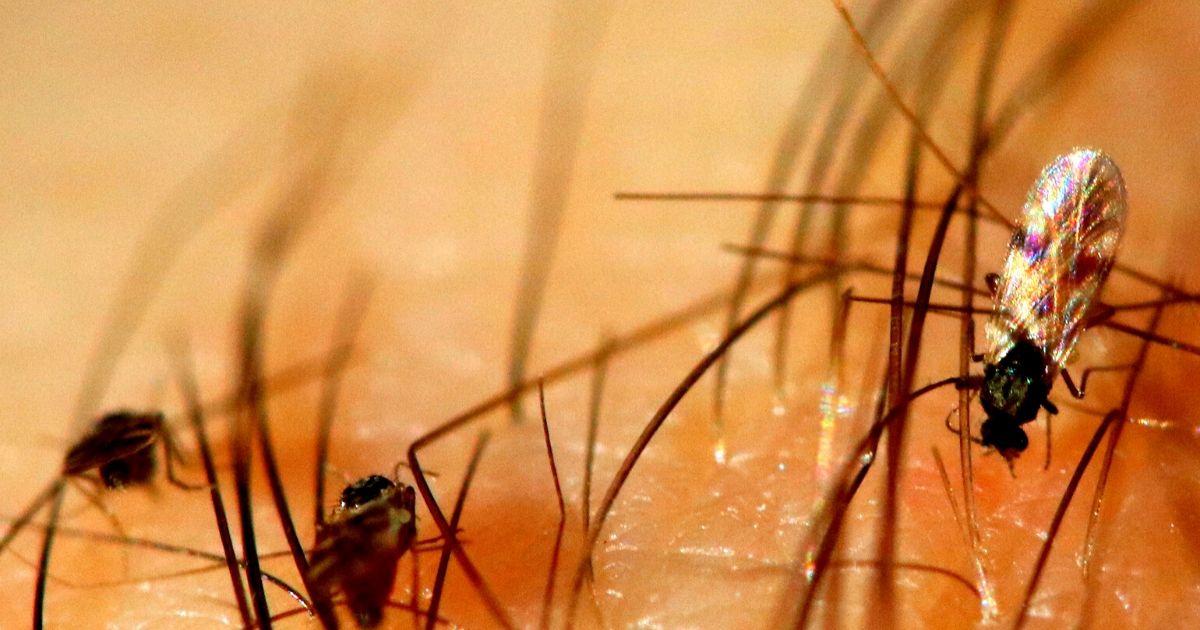
In this article, we’ll discuss 7 ways how to get rid of midges in Singapore. Over many years, the presence of non-biting midge swarms at Bedok Reservoir and Pandan Reservoir have been recorded in July, August, and September. This hot and rainy time of the year makes the environment conducive for their multiplication.
The insect is not a new guest to Singapore but the spike in their numbers has caused more problems to us than before.
The appearance of non-biting midges is similar to that of mosquitoes. However, if you look closely, you will notice some distinctive features such as the absence of proboscis (needle-like sucking mouthparts) and the more slender and longer body present in the midges.
As their name implies, non-biting midges do not bite. Also, they do not transmit diseases. They are nuisance pests because they often appear in large swarms and the encounter with them can be annoying to some people.
How to get rid of midges? It is almost impossible to eliminate them completely as they are part of nutrient-rich aquatic habitats. Nonetheless, we can prevent or reduce their breeding habitats.
7 Tips of How to Get Rid of Midges
1. Use Insect Repellent
Repellents do not kill midges but can repel them from staying close to you. You may be concerned about the chemical-laden repellents that would harm your skin. However, the recent release of natural insect repellents in the market using naturally occurring substances such as tea tree or citronella oil perhaps can help to put this thought aside.
Although non-biting midges will not harm us, they may cause nuisance, ruin our perfect outdoor lunch or dinner, and disrupt our workout routine.
Applying insect repellent to your body will be the best natural way how to get rid of midges.
Want to find out more about midges removal in Singapore?
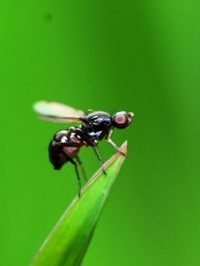
2. Keep Doors and Windows Tightly Closed or Screened
Remind yourself to always keep doors and windows tightly closed to prevent midges from gaining access to your home. You can screen your windows with fine mesh and make sure the holes are small enough to block midges (body length: 5 to 8mm) from flying in.
Doors are the most susceptible entry points for flying midges. Make sure the doors or windows are closed during dusk and dawn as these are the most active time for both midges and Aedes mosquitoes. Curtains can be installed to lower the chance of midges entering.

3. Minimize the Use of Bright Lights
Insects such as bees, flying ants, and flying termites are attracted to lights because they use light to navigate their flight or simply because of the warmth given off by the lights. Midges are highly attracted to bright light. It is advisable to use yellow light bulbs or dim light, especially at the main door to keep midges away from your home.
Relocate the bright lights that are located at entrances to other places or tint the light bulbs to pink or orange colour. One of the most recommended ways to keep midges away from your home is to switch off the lights that are not in use or reduce the use of lights in your home exteriors.
4. Prevent Stagnant or Slow-Flowing Water
Like mosquitoes, the life cycle of midges involves aquatic and terrestrial stages. The larvae and pupae of midges are found in water bodies such as lakes, ponds, water reservoirs, as well as any other stagnant or slow-moving water. One of the locations where pests are commonly found at home revolves around plants and greenery.
Pro Tip: Over-watering of plants often causes the formation of stagnant water on the soil and planter boxes.
The nutrients in the soil further facilitate the growth and development of midges. Avoid over-watering plants and loosen the soil regularly to prevent the formation of ponding water.
Drains with slow-flowing water are also ideal breeding sites for midges. The immature stages are able to withstand the weak water current in the drain and are constantly supplied with nutrients required for the development. We can make the environment less conducive by improving the flow of drain water through the removal of blockages.
5. Reduce the Use of Fertilizer
As discussed earlier, midges prefer to breed in nutrient-rich habitats. Fertilizers are meant to promote the growth of healthy plants but they can also provide nutrients to other organisms found in the garden such as millipedes and insects. Excessive use of fertilizer causes fertilizer runoff in the soil to nearer ponds or streams, supplying the water bodies with ample nutrients which then contribute to the development of midges.
Proper use of fertilizer and nutrient management should be employed to reduce the potential breeding sources for midges. Remember to always check and fertilize your plants according to the guidelines and directions of use. This does not only help to reduce the midge population but also promotes the growth of healthy plants.
6. Biological Approach (Bti / Mosquito Dunk)
You might have heard of a mosquito dunk (a donut-shaped larvicide that slowly dissolves and kills mosquitoes). It contains a bacterium known as Bti (Bacillus thuringiensis israelensis) which infects the guts (stomach) of the larvae. Bti is an environmentally friendly control agent as it does not affect non-target organisms.
In that case, it is safe to use Bti in the presence of aquatic animals such as fish and it does not kill beneficial insects such as honey bees.
Besides using mosquito dunks to treat mosquito breeding, it can also be used to control the populations of other aquatic insects including midges.
You can place a mosquito dunk in potential breeding sites of midges such as ponds or gutters and the larvicide will slowly release the Bti to kill the larvae in the water bodies.

Pest Problem? Let Us Help.
We offer fast and effective precision treatments to eliminate pests while ensuring a safe environment for your home or business.
7. How to Get Rid of Midges: Seek Help From a Professional
The recommended measures discussed above prevent midges from disturbing your life. However, their presence is often inevitable in uncontrollable situations or specific environments. Adoption of permanent measures is strongly advised to address and eliminate the root cause of midges. To help combat this pesky pest, you may seek help from our expert team.
Frequently Asked Questions
Some midges do bite. There are reported cases of severe reactions after a person got bitten by midges. It is important to take preventive action to limit the risk of getting bitten by midges.
Midges are especially attracted to humans due to their body heat and odour. You can reduce your risk of getting bitten by midges by following the tips in this article.
Midges are small flies. They are similar to mosquitoes.

